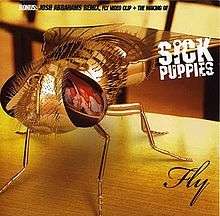
Fly (Phillip Phillips song)
"Fly" is a song by American singer-songwriter Phillip Phillips from his second studio album, Behind the Light, which will be released by Interscope Records.
Background
"Fly" was recorded in New York City and was produced by Todd Clark.
Lyrical interpretation
MUSICInsideU says that "Fly is about the battle between who people think he is and tie him down to, and who he really is. "These people never notice me. Am I the only one who thinks it's hard." Phillip breaks other people's categories of him, mixing rock guitar solos with his typical acoustic sound. His almost-country style voice also blends with darker rock lyrics in the new single Fly." He added "The meaning of Phillip Phillips' Fly is about who he is - applied to you, it's about who you are. Outside, there's "the busy street... these people never notice me." I don't fit in, says Phillip, "it's hard to say what's on my mind." The questions are "give up? How should I survive?" A part feels like just giving in and blending into the "two thousand faces" of the crowd. The deeper part of Phillip rebels against just being like everyone else. "Think your fight is over? It's only so much closer." Phillip won't give up breaking out of the walls of this "cruel maze" of a nameless society: "I reach my hands to the sky... and fly!""

Fly (EP)
Fly is the second EP released by rock band Sick Puppies. It was released in 2003 and features 6 tracks; including a remix by Josh Abrahams, an Enhanced CD featuring the making of the "Fly" music video and a rare version of the clip exclusive to the CD. It is the last release to feature Chris Mileski on drums.
Track listing
All lyrics written by Shim Moore, all music composed by Shim Moore, Emma Anzai and Chris Mileski.
Personnel
Credits for Fly adapted from liner notes.
References

Fly (Archie Comics)
The Fly is a fictional comic book superhero published by Red Circle Comics. He was created by Joe Simon and Jack Kirby as part of Archie's "Archie Adventure Series" and later camped up (as Fly Man) as part of the company's Mighty Comics line. He first appeared in The Double Life of Private Strong #1, however his origin story and first "full length" appearance were in Adventures of the Fly #1 (Aug. 1959).
Publication history
After the first four issues of Adventures of the Fly (Simon and Kirby left the title after the fourth issue), others took on the character and made him an adult lawyer who fought crime in Capital City. He was later partnered with Fly Girl.
Adventures of The Fly was cancelled with issue #30 (Oct. 1964). The Fly also appeared in short stories in some of Archie's other titles (The Double Life of Private Strong #1, #2 both published in 1959), (Pep Comics #151, 154, 160 and Laugh #128, 129, 132, 134, 137-139) between October 1961 and January 1963. His own series was restarted as Fly-Man as part of the "Mighty Comics Group", which ran from issues #31-39 (May 1965 - Sept. 1966). The title changed again to Mighty Comics, which featured various Archie super-heroes in solo adventures for #40-50 before its cancellation in 1967.
Albion (given name)
Albion is a given name, usually masculine, which may refer to:

Albion Motors
Albion Automotive of Scotstoun, Glasgow is a former Scottish automobile and commercial vehicle manufacturer. It is currently involved in the manufacture and supply of Automotive component systems.
From WW1 to the 1950s, Albion had rivalled Foden for the reliability and ruggedness of their trucks. Albion was incorporated into Leyland Motors in 1951, and merely became a badge for their smaller lines. The badge was dropped by British Leyland in 1980.
Today the company is a subsidiary of American Axle & Manufacturing, and manufactures axles, driveline systems, chassis systems, crankshafts and chassis components. It is Scotland's best known name in the motor industry. Albions were renowned for their slogan "Sure as the Sunrise".
History
Originally known as Albion Motor Car Company Ltd, the company was founded in 1899 by Thomas Blackwood Murray and Norman Osborne Fulton (both of whom had previously been involved in Arrol-Johnston) they were joined a couple of years later by John F Henderson who provided additional capital. The factory was originally on the first floor of a building in Finnieston Street, Glasgow and had only seven employees. In 1903 the company moved to new premises in Scotstoun.

Equatorium
An equatorium (plural, equatoria) is an astronomical calculating instrument. It can be used for finding the positions of the Moon, Sun, and planets without calculation, using a geometrical model to represent the position of a given celestial body.
The earliest extant record of a solar equatorium, that is, one to find the position of the sun, is found in Proclus's fifth-century work Hypostasis, where he gives instructions on how to construct one in wood or bronze. Although planetary equatoria were also probably made by the ancient Greeks, the first surviving description of one is from the Libros del saber de astronomia (Books of the knowledge of astronomy), a Castilian compilation of astronomical works collected under the patronage of Alfonso X of Castile in the thirteenth century, which includes translations of two eleventh century Arabic texts on equatoria by Ibn al‐Samḥ and al-Zarqālī.Theorica Planetarum (c. 1261-1264) by Campanus of Novara describes the construction of an equatorium, the earliest known description in Latin Europe.
Podcasts:

